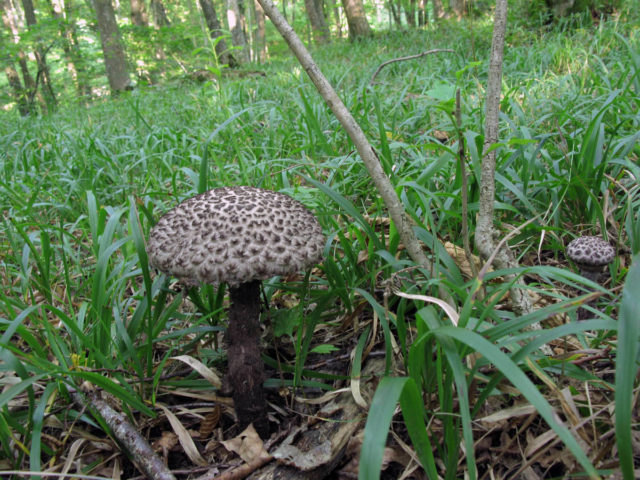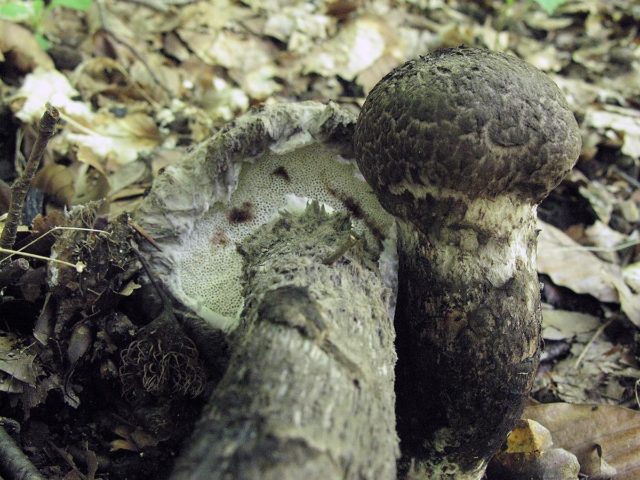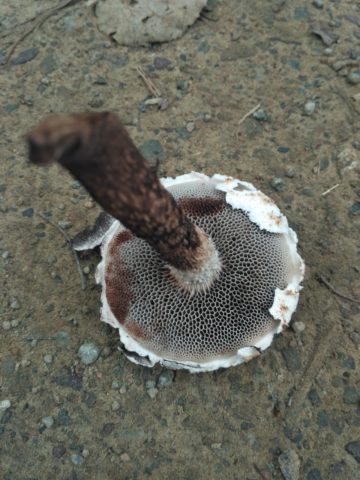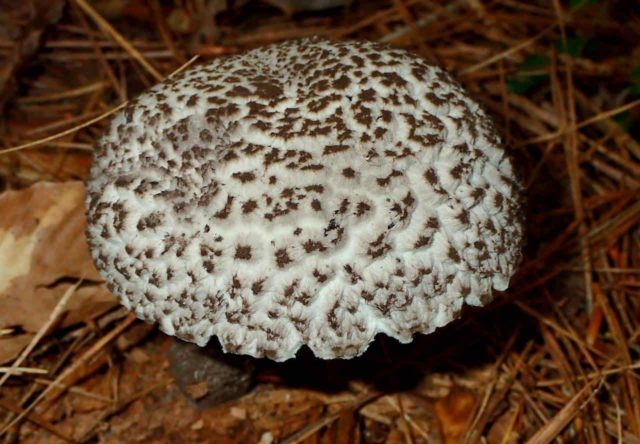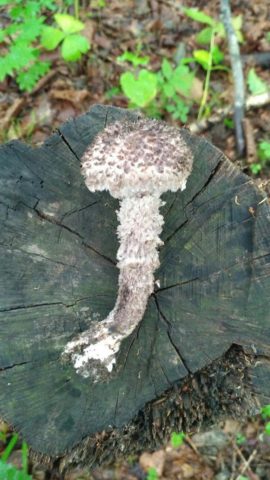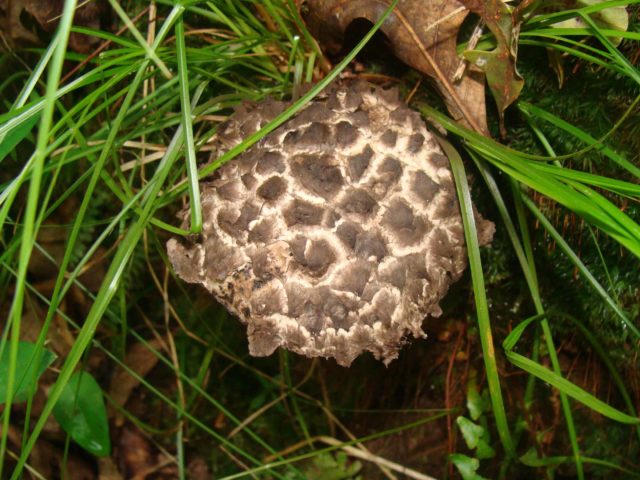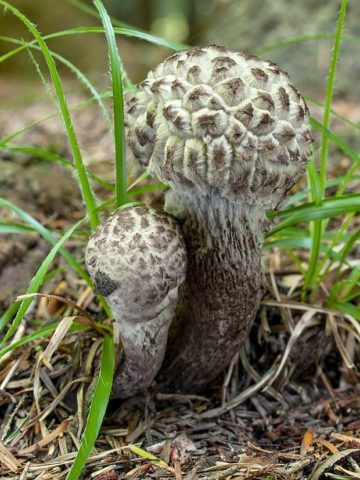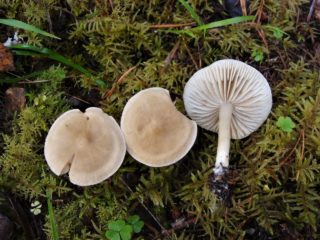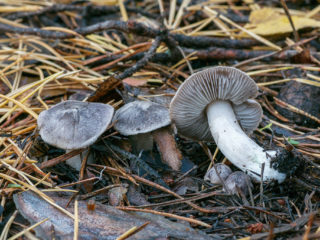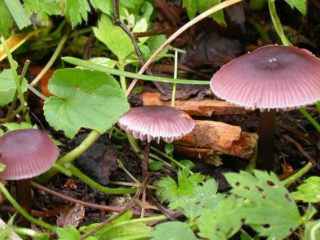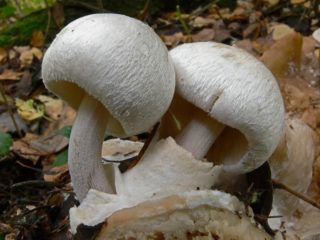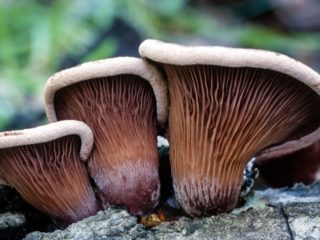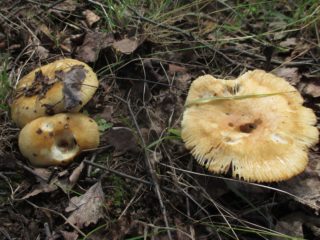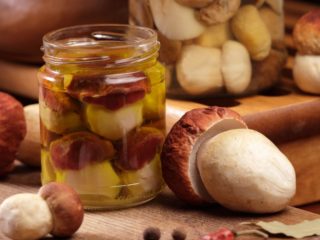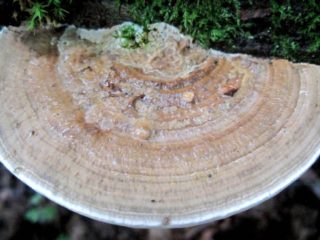Content
In addition to its official name, the flocculus mushroom is known as the Old Man or Leshy. The mushroom belongs to the Boletaceae family, a small genus of the Shishkogrib. Rarely found in nature, the endangered species is listed in the Red Book.
Description of the cone mushroom
The appearance is so unattractive that inexperienced mushroom pickers pass by, mistaking the fruiting bodies for poisonous. The cone mushroom (pictured) is completely covered with gray or dark brown scales. The color darkens over time, the coating forms in the form of detachable convex seals.Young specimens look like a conifer cone, and the bristly covering of the leg is gray flakes, hence the name.
Description of the cap
The shape changes during the growing season; in newly emerged specimens it is spherical, attached to the stem with a blanket. Then the veil is torn, the shape of the cap takes on a convex appearance, and after 2-4 days it becomes flat. By this time, the flocculus mushroom is entering the stage of biological aging and is of no value in gastronomic terms.
External characteristics:
- The fruiting bodies are large; in some individuals the caps grow to 13-15 cm in diameter. The surface is white with convex seals in the form of brown or dark gray scales of various shapes and sizes. The edges are uneven with torn fragments.
- The lower part is tubular, porous, the cells are angular. Young specimens are distinguished by a white hymenophore, while adults are dark brown or black.
- The pulp is tasteless and odorless. When cut, it turns bright orange when oxidized; after a few hours it becomes inky in color.
- The spores are presented in the form of a black powder.
Description of the leg
The shape is cylindrical, widened at the base, upright or slightly curved.
The color is the same as the cap. Length – 10-13 cm. The surface is hard, fibrous. The leg is covered with large bristly flakes. The trace of the ring is clearly visible in the upper part. The structure is hollow; by biological ripeness, the fibers become rigid, so the stems are not used for processing.
Is the cone mushroom edible or not?
There are no toxins in the chemical composition of the fruiting body. In Europe and America, Shishkogrib is included in the menu of certain restaurants and cafes.In Russia, due to the lack of smell and unexpressed taste, the cone mushroom is classified as a conditionally edible mushroom. Only young specimens or caps are processed. Old cone mushrooms have a dry cap, and the stem remains hard even when hot processed.
How to cook Pine mushroom
The flaked cone mushroom is universal in processing. The fruiting bodies can be used for cooking and preparing food for the winter. Mushrooms are fried, stewed, boiled, dried. There is no bitterness in the taste, there are no toxic compounds in the composition, so there is no need for pre-soaking.
The crop is cleaned of soil, grass and leaves, hard stems are cut off, and washed with hot water. Dip into salted water, add citric acid, leave for 15-20 minutes. If there are insects in the fruiting body, they will leave it. The fruits are cut into arbitrary pieces and processed.
How to salt
Salted mushrooms do not differ in taste from species with high nutritional value: milk mushrooms, saffron milk caps, and butter mushrooms. A simple recipe for pickling the cone mushroom is designed for 1 kg of fruiting bodies; for preparation you will need salt (50 g) and spices to taste. Salting algorithm:
- The washed fruits are dried so that no liquid remains.
- Prepare the containers. If these are glass jars, they are doused with boiling water; wooden or enamel dishes are cleaned with baking soda, washed well and treated with boiling water.
- Blackcurrant or cherry leaves are placed at the bottom.
- On top is a layer of cone mushrooms, sprinkle with salt.
- Add pepper and dill seeds.
- Spread in layers, cover with leaves on top and add bay leaf.
- Cover with a cotton napkin or gauze, and place a weight on top.
Place the preparation in a cool place, after a few days the juice will appear and should completely cover the fruiting bodies.
How to marinate
Only the caps are marinated (regardless of the age of the mushroom). For the recipe take:
- Cone mushroom – 1 kg;
- bay leaf – 2 pcs.;
- sugar – 1 tbsp. l.;
- vinegar - 2.5 tbsp. l. (better 6%);
- citric acid – ¼ tsp;
- salt – 0.5 tbsp. l.;
- water – 0.5 l.
Mushrooms, sugar, bay leaves, salt, citric acid are placed in water and boiled for 20 minutes. During this time, the jars are sterilized. Add vinegar 5 minutes before cooking. The boiling mass is placed in containers and covered with lids.
Where and how does it grow
The mushroom grows in regions with cold climates. The distribution area of the cone mushroom is the Ural, Far East, Siberia. Can be found in the Moscow region. It grows solitarily, less often in 2-3 specimens in mixed forests with a predominance of coniferous trees. Settles in acidic soils in lowlands or hills.
The species bears fruit from mid-summer until the onset of frost. Rarely found, the cone mushroom is an endangered species of mushroom. Industrial development affects air pollution; the fungus does not grow in polluted environmental conditions. Deforestation, fires and soil compaction contribute to the extinction of the species. These negative factors almost completely destroyed the population of the species, which is why the cone mushroom is listed in the Red Book and is protected by law.
Doubles and their differences
The cone mushroom has no false counterparts. Externally similar to Strobilomyces confusus.
The double is characterized by identical nutritional value and is also a rare species. The time of appearance and place of growth are the same for them. Strobilomyces confusus has larger scales on the cap; they clearly protrude above the surface.The lower tubular part has smaller cells.
Conclusion
The flocculus mushroom is an endangered species. Grows in the northern regions and partly in temperate climates. Mushrooms are collected from mid-summer to late autumn. The fruit bodies do not have a distinct taste or smell, are universal in use, and are used for preparing dishes: they are salted, pickled, and dried.
